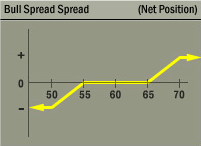Double Bull Spread
This strategy is the combination of a bull call spread and a bull put spread.
Description
This strategy consists of being long one call and short another call with a higher strike, and short one put with a long put on a lower strike. Typically, the call strikes are above and the put strikes below the current level of underlying stock, and the distance between the call strikes equals the distance between the put strikes. All options must have the same expiration date.
Outlook
Looking for rising stock price.
Summary
This strategy is the combination of a bull call spread and a bull put spread. A key part of the strategy is to initiate the position at even money, so the cost of the call spread should be offset by the proceeds from the put spread.
Motivation
Profit from a rising stock price.
Variations
N/A

- Short 1 XYZ 70 call
- Long 1 XYZ 65 call
- Short 1 XYZ 55 put
- Long 1 XYZ 50 put
MAXIMUM GAIN
- High call strike - low call strike - net premium paid
MAXIMUM LOSS
- High put strike - low put strike - net premium paid
Max Loss
The maximum loss would occur should the underlying stock be below the lower put strike at expiration. In that case, both puts would be in-the-money, and the loss would be the difference between the put strike prices plus or minus any premium paid or received from initiating the position.
Max Gain
The maximum gain would occur should the underlying stock be above the upper call strike at expiration. In that scenario, both calls would be in-the-money, and the gain would be the difference between the call strike prices plus or minus any premium received or paid from initiating the position.
Profit/Loss
The potential profit and loss are both limited. The maximum profit occurs when the underlying stock goes above the upper call strike. The maximum loss occurs when the underlying stock goes below the lower put strike.
Breakeven
If this strategy is initiated at even money, then breakeven is anywhere that all the options expire worthless, i.e., between the lower call strike and upper put strike. If a premium was paid or received, then breakeven would occur where the underlying stock at expiration is above the lower call strike price by the premium paid or below the upper put by the premium paid.
Volatility
An increase in implied volatility will, all other things equal, generally have only a slight impact on this strategy. Whether the impact is positive or negative depends on which options are in-the-money or out-of-the-money, the time to expiration and level of interest rates.
Time Decay
The passage of time will, all other things equal, generally have only a slight impact on this strategy. Whether the impact is positive or negative depends on which the options are in-the-money or out-of-the-money, the time to expiration and level of interest rates.
Assignment Risk
Yes. Early assignment, while possible at any time, generally occurs for a call when the stock goes ex-dividend and for a put when it goes deep in-the-money.
And be aware, a situation where a stock is involved in a restructuring or capitalization event, such as a merger, takeover, spin-off or special dividend, could completely upset typical expectations regarding early exercise of options on the stock.
Expiration Risk
Yes. The investor cannot know for sure whether or not they will be assigned on a short option until the Monday after expiration. If unexpected exercise activity occurs, they could find themselves with a stock position on the Monday following expiration and subject to an adverse move in the stock over the weekend.
Comments
N/A
Related Position
Comparable Position: N/A
Opposite Position: Double Bear Spread

